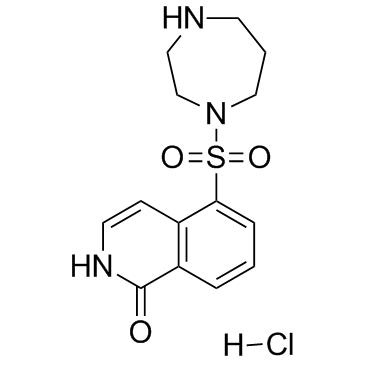155558-32-0
| Name | 5-(1,4-diazepan-1-ylsulfonyl)-2H-isoquinolin-1-one,hydrochloride |
|---|---|
| Synonyms |
5-(1,4-Diazepan-1-ylsulfonyl)isoquinolin-1-ol hydrochloride (1:1)
1-(1-Hydroxy-5-isoquinolinesulfonyl)homopiperazine hydrochloride hydrate 5-(1,4-Diazepan-1-ylsulfonyl)-1(2H)-isoquinolinone hydrochloride (1:1) HA1100 Hydrochloride HYDROXYFASUDIL 1(2H)-Isoquinolinone, 5-[(hexahydro-1H-1,4-diazepin-1-yl)sulfonyl]-, hydrochloride (1:1) Hydroxyfasudil monohydrochloride HA1100 Hydroxy Fasudil Hydrochloride Fasudil Impurity 7 HCl Hydroxyfasudil (hydrochloride) |
| Description | Hydroxyfasudil hydrochloride is a ROCK inhibitor, with IC50s of 0.73 and 0.72 μM for ROCK1 and ROCK2, respectively. |
|---|---|
| Related Catalog | |
| Target |
ROCK2:0.72 μM (IC50) ROCK1:0.73 μM (IC50) PKA:37 μM (IC50) |
| In Vitro | Hydroxyfasudil hydrochloride is a ROCK inhibitor, with IC50s of 0.73 and 0.72 μM for ROCK1 and ROCK2, respectively. Hydroxyfasudil also less potently inhibits PKA, with an IC50 of 37 μM, 50-fold higher than those of the ROCKs. Hydroxyfasudil increases eNOS mRNA levels, with an EC50 value of 0.8 ± 0.3 μM. Hydroxyfasudil (0-100 μM) concentration-dependently increases eNOS activity and stimulates NO production in human aortic endothelial cells (HAEC). Hydroxyfasudil (10 μM) increases the half-life of eNOS mRNA from 13 to 16 hours, but does not affect eNOS promoter activity at concentrations from 0.1 to 100 μM[1]. |
| In Vivo | Hydroxyfasudil (10 mg/kg, i.p.) significantly increases both the average and maximal voided volumes in SD rats. Hydroxyfasudil also significantly decreases the maximal detrusor pressure[2]. Hydroxyfasudil (3 mg/kg, i.p) inhibits hypercontractility induced by norepinephrine in spontaneously hypertensive rats (SHRs). Furthermore, Hydroxyfasudil (3, 10 mg/kg, i.p) significantly ameliorates decreased penile cGMP contents in rats[3]. |
| Animal Admin | Micturition behavior is studied after intraperitoneal injection of either Hydroxyfasudil (10 mg/kg) or a corresponding volume of saline. Each rat is placed in a metabolic cage containing a urine collection funnel that is placed over an electronic balance. The balance is connected to a personal computer via a multiport controller and used to measure the cumulative weight of the collected urine. Every 150 s during a continuous 24-h period, the computer samples and records the data for the micturition frequency and volumes. The micturition reflex parameters that are collected includ: urine volume per micturition, maximal micturition volume, micturition frequency, and total urine output in the Hydroxyfasudil- or vehicle-treated animals. Each monitoring session started at 18.00 hours. Prior to being placed in the metabolic cage at the start of each experimental period, the animals receive either a single injection of Hydroxyfasudil (10 mg/kg) dissolved in saline or an injection of saline without the inhibitor[2]. |
| References |
| Melting Point | >250ºC(dec.) |
|---|---|
| Molecular Formula | C14H18ClN3O3S |
| Molecular Weight | 343.829 |
| Exact Mass | 343.075745 |
| PSA | 90.91000 |
| LogP | 3.07390 |
| Hazard Codes | Xn: Harmful; |
|---|---|
| Risk Phrases | R22 |
